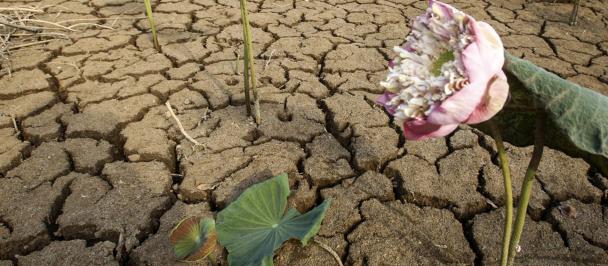លោក រាម មូសាវី កំពុងកាន់គ្រុំចំពុះទាសំបកខៀវដែលចិញ្ចឹមក្នុងកន្លែងជម្រកត្រីសហគមន៍ | Mr. Ream Mosavy is collecting blue shells raised in the community fish nursery habitat.
[English Below]
នៅពេលព្រលឹមថ្ងៃមួយ លោក រាម មូសាវី កំពុងដើររើសគ្រុំចំពុះទាសំបកខៀវនៅតាមកន្លែងចិញ្ចឹមត្រីបែបធម្មជាតិក្នុងតំបន់ព្រៃកោងកាងតាម បណ្តោយឆ្នេរសមុទ្រក្នុងសហគមន៍នេសាទព្រៃនប់ ២។ អស់ជាច្រើនជំនាន់មកហើយ សហគមន៍នេះប្រកបរបរចិញ្ចឹម ជីវិតដោយពឹងផ្អែកលើការប្រមូលគ្រុំ
ជំពុះទា។
លោក មូ សាវី ដែលជាប្រធានសហគមន៍មានប្រសាសន៍ថា «សហគមន៍របស់យើងពឹងផ្អែកយ៉ាងធំធេងលើធនធានធម្មជាតិដូចជានេសាទ និងព្រៃ
ឈើសម្រាប់បំពេញតម្រូវការប្រចាំថ្ងៃរបស់យើង ហើយយើងមិនចាំបាច់ចំណាយប្រាក់ច្រើនទៅលើការទិញអាហារឡើយ។ ប្រសិនបើព្រៃឈើបាត់បង់អស់
នោះយើងនឹងពិបាករស់ណាស់។» ក្នុងឆ្នាំ ២០១៦ ផ្ទៃដីព្រៃកោងកាងប្រហែលជា ៤៥ ហិចតាក្នុងដីសហគមន៍ត្រូវបានទន្ទ្រានដោយអ្នកជំនួញដ៏មានអំណាច
ម្នាក់ក្នុងគោលបំណងប្រែក្លាយទីនោះឱ្យទៅជាចំការដូង។
លោក មូសាវីបានដឹងជាមុនថា ប្រសិនបើសហគមន៍មិនបានធ្វើសកម្មភាពក្នុងពេលឆាប់ៗនោះទេ ពួកគេនឹងបាត់បង់ដីរបស់ខ្លួន។ ដូច្នេះសហគមន៍ បានរៀបចំយុទ្ធនាការមួយដើម្បីទទួលបានការគ្រប់គ្រងដីនោះឡើងវិញ។ ទីមួយ ពួកគាត់បានដាក់ពាក្យបណ្តឹងជាផ្លូវការមួយច្បាប់ ដោយមានការគាំទ្រពី
រដ្ឋបាលជលផល។ ដោយឈរលើស្មារតីសាមគ្គីភាពផ្ទៃក្នុង សមាជិកសហគមន៍ទាំងអស់បានប្រឆាំងនឹងអ្នកជំនួញដ៏មានឥទ្ធិពលម្នាក់នោះដោយពួកគេបាន
ចុះហត្ថលេខា ឬផ្តិតមេដៃលើពាក្យបណ្តឹងនេះ។
សហគមន៍ព្រៃនប់ ត្រូវបានចុះបញ្ជីជាសហគមន៍នេសាទ មានឯកសារច្បាប់ត្រឹមត្រូវអនុម័តដោយក្រសួងកសិកម្ម រុក្ខាប្រមាញ់ និងនេសាទ ដែលបាន
កំណត់អំពី ព្រំប្រទល់ដីសហគមន៍ច្បាស់លាស់ មានវិធាន និងបទបញ្ញត្តិផ្ទៃក្នុងគ្រប់គ្រាន់ ដើម្បីគ្រប់គ្រងធនធានក្នុងសហគមន៍ជាទ្រព្យសម្បត្តិរួម។
ស្ថានការណ៍នេះ បានធ្វើឱ្យសហគមន៍ព្រៃនប់មានជំហរកាន់តែរឹងមាំក្នុងការអនុវត្តសិទ្ធិសហគមន៍ប្រឆាំងនឹងការទន្ទ្រានពីអ្នកខាងក្រៅ។
It’s early Tuesday morning, and along a dike that separates the mangrove forest from the fish nursery habitat, Ream Mosavy, is collecting blue shell mussels. For generations, his community has harvested mussels here, a means to their very survival.
But in 2016, a powerful business person grabbed 45 hectares of the community’s land, threatening the community’s food supply. Approximately 45 hectares of the mangrove forest was encroached on by an entrepreneur who wanted to convert the land into a coconut plantation.
“Our community largely depends on natural resources – fishing and forests – for our daily needs and we don’t have to spend a lot of money on purchasing food items. If the forest is no more, we would find it extremely difficult to survive,” says Mr. Mosavy Chief of the Preynub II Community Fishery. Mosavy knew if the community did not act soon, they would lose their land. So, they organized a campaign to regain control of it.
First, a formal complaint was filed with support from the Fisheries Administration. In a sign of internal solidarity, all community members stood up against the entrepreneur and either signed or put their thumbprint on the complaint.
Preynub, as a registered community fishery, has legal documents endorsed by the Ministry of Agriculture, Forestry and Fisheries that include a clear defined boundary, and internal rules and regulations to manage resources on its common property. This status put Preynub in a relatively stronger position to exercise its community’s rights, in excluding outsiders.
សមាជិកសហគមន៍ និងងាវដែលរកបានពីសមុទ្រ | Villagers with blood cockles collected from the sea
ក្នុងការតស៊ូមតិតទល់នឹងបុគ្គលមានអំណាចដែលមានបំណងទន្ទ្រានដីព្រៃរបស់សហគមន៍ សហគមន៍ព្រៃនប់បានប្រើប្រាស់ប្រព័ន្ធផ្សព្វផ្សាយ
ដើម្បីលាតត្រដាងបញ្ហានេះ។ ពួកគេបានទាក់ទងទៅប៉ុស្តិ៍ទូរទស្សន៍នានា ហើយបានផ្តល់ព័ត៌មានអំពីការទន្ទ្រាននេះ។ បញ្ហានេះក៏ត្រូវបានផ្សព្វផ្សាយ
យ៉ាងទូលំទូលាយក្នុងបណ្តាញសារព័ត៌មានរហូតដល់មានចំណាប់អារម្មណ៍ពីអាជ្ញាធរថ្នាក់ខេត្ត និងថ្នាក់ជាតិ។
អភិបាលខេត្តព្រះសីហនុបានអំពាវនាវឱ្យមានការស៊ើបអង្កេតជាបន្ទាន់មួយដែលនាំឱ្យសហគន៍ទទួលបានដីរបស់ខ្លួនមកវិញដោយមាន ការធានាថានឹងគ្មានការប៉ុនប៉ងទន្ទ្រានដីរបស់សហគមន៍ទៀតឡើយ។
លោក មូសាវី មានប្រសាសន៍ថា «ដោយសារតែធនធានធម្មជាតិក្នុងសហគមន៍នេះជាប្រភពនៃអាហារ សម្រាប់ការរស់នៅរបស់យើង ទើប
យើងទាំងអស់គ្នាខិតខំប្រឹងប្រែងយ៉ាងខ្លាំងដើម្បីថែរក្សាធនធានក្នុងសហគមន៍។ យើងមិនត្រឹមតែអាចគ្រប់គ្រងធនធានរបស់យើងប៉ុណ្ណោះទេ
ប្រសិនបចាំបាច់ យើងក៏អាចប្រមូលផ្តុំកិច្ចខិតខំប្រឹងប្រែងរួមគ្នា ដើម្បីបញ្ឈប់រាល់ការទន្ទ្រានដីព្រៃរបស់យើងពីអ្នកខាងក្រៅផងដែរ។»
សហគមន៍នេសាទព្រៃនប់ ២ ទទួលខុសត្រូវលើការគ្រប់គ្រងផ្ទៃដីចំនួន ៤៥០០ ហិកតា ដែលគ្របដណ្តប់ដោយព្រៃកោងកាងចំនួន ៦៥០
ហិកតា។ សហគមន៍ព្រៃនប់សម្បូរនៅដោយធនធាន និងមានទីតាំងតាមបណ្តោយផ្លូវជាតិ ដែលផ្តល់ភាពងាយស្រួលដល់សហគមន៍ក្នុងការប្រើប្រាស់
និងទទួលផលពីធនធានធម្មជាតិ និងទេសចរណ៍ធម្មជាតិ។ ទីតាំងសហគមន៍ក៏ផ្តល់ភាពភាពងាយស្រួលក្នុងការធ្វើដំណើរទៅទីផ្សារ និងប្រើប្រាស់
សេវាកម្មសាធារណៈនានាផងដែរ។
កម្មវិធី REDD+ កម្ពុជា ដែលគាំទ្រដោយកម្មវិធីអភិវឌ្ឍន៍សហប្រជាជាតិ (យូអិនឌីភី) និងកម្មវិធីសម្របសម្រួលភាពជាដៃគូកាបូនព្រៃឈើ
ដោយសហការជាមួយរដ្ឋបាលជលផល គាំទ្រកិច្ចខិតខំប្រឹងប្រែងរបស់សហគមន៍ព្រៃនប់ដើម្បីកាត់បន្ថយការកាប់បំផ្លាញព្រៃឈើ និងការបាត់បង់
ព្រៃឈើ។
កម្មវិធីនេះបង្កើនសមត្ថភាពរបស់សហគមន៍មូលដ្ឋាន និងអាជ្ញាធរមូលដ្ឋានដើម្បីដោះស្រាយការទន្ទ្រានព្រៃឈើតាមរយៈការបង្កើនការយល់
ដឹង សកម្មភាពល្បាត ការរាយការណ៍ និងការចងក្រងឯកសារ។ លើសពីនេះទៅទៀត កម្មវិធីក៏បានជួយសហគមន៍បង្កើតជម្រើសមុខរបរចិញ្ចឹម
ជីវិតផ្សេងៗ ដូចជា ទេសចរណ៍ធម្មជាតិ ដែលអាចផ្តល់នូវការលើកទឹកចិត្តដល់សហគមន៍ក្នុងការចូលរួមការពារធនធានទាំងនេះ។ រាជរដ្ឋាភិបាល ទទួលស្គាល់ថាសហគមន៍រឹងមាំនាំមកនូវការការពារបរិស្ថានល្អប្រសើរ និងកំណើនសេដ្ឋកិច្ចកាន់តែខ្លាំង។
សេចក្តីព្រាងនៃក្រមបរិស្ថាន ក្រោមការដឹកនាំរបស់រដ្ឋមន្រ្តីក្រសួងបរិស្ថាន ឯកឧត្តម សាយ សំអាល់ បានផ្តល់អំណាចយ៉ាងទូលំទូលាយដល់
អាជ្ញាធរមូលដ្ឋាន និងសហគមន៍មូលដ្ឋាន។ សេចក្តីព្រាងក្រមនេះ ក៏ផ្តល់នូវទិសដៅថ្មីមួយសម្រាប់ការអភិវឌ្ឍប្រកបដោយចីរភាព និងការផ្ទេរអំណា
ចដល់ក្រុមប្រឹក្សាឃុំសង្កាត់ និងសហគមន៍មូលដ្ឋានផងដែរ។ ភាពជោគជ័យរបស់សហគមន៍ព្រៃនប់ក្នុងការទទួលបានដីរបស់ខ្លួនមកវិញបានបង្ហាញ
ថា សហគមន៍មានអំណាចក្នុងការប្រមូលផ្តុំ និងធ្វើការជាមួយអាជ្ញាធរមូលដ្ឋានក្នុងការការពារធនធាន និងទ្រព្យសម្បត្តិរបស់ពួកគេ។ នេះជាមេរៀន
ដ៏សំខាន់មួយសម្រាប់សហគមន៍ផ្សេងៗទៀតដែលប្រឈមនឹងស្ថានភាពស្រដៀងៗគ្នានេះ។
To counter the powerful vested interests that were responsible for encroachment, Preynub used the mass media, to shine a light on the issue. They reached out to television channels and provided information on the encroachment. Their story received heavy news coverage, and attracted the attention of provincial and national authorities.
The Provincial Governor quickly called for an investigation that led to the community being granted back its land, with a commitment of no further attempts at encroachment.
“It’s because of this dependence (for food) that our community makes special efforts to take care of our resources,” Mosavy says. “We are able to not only manage our resources, but if required can also mobilize collective efforts to stop encroachment of our forest land from external commercial interests.”
The Preynub II Community Fishery is responsible for managing an area of 4500 hectares that comprises 650 hectares of mangrove forest. Its prized location, close to rich resources and along the national highway, provides it with easy access to natural resources, local markets, and public services.
The Cambodia REDD+ Programme, supported by UNDP and the Forest Carbon Partnership Facilities, in collaboration with Fisheries Administration, supports Preynub’s efforts to reduce deforestation and forest degradation.
The programme enhances capacity of local communities and authorities to address forest encroachment through awareness raising, patrolling activities, reporting, and documentation. In addition, new and alternative livelihood opportunities such as eco-tourism provide an incentive for communities to protect resources.
There are signs too that within Government there is recognition that strong communities bring both better protection of the environment and stronger economic growth. The draft Environmental Codes, championed by Minister of Environment Say Samal, give wide ranging powers to local government and local communities. The codes also provide a new direction in sustainable development, and a radical transfer of powers to local councils and communities.
Preynub’s success in regaining its land proves that empowered local communities that band together and work with the local authorities can protect their resources and property. It can serve as an important lesson for other communities facing similar situations.

 Locations
Locations